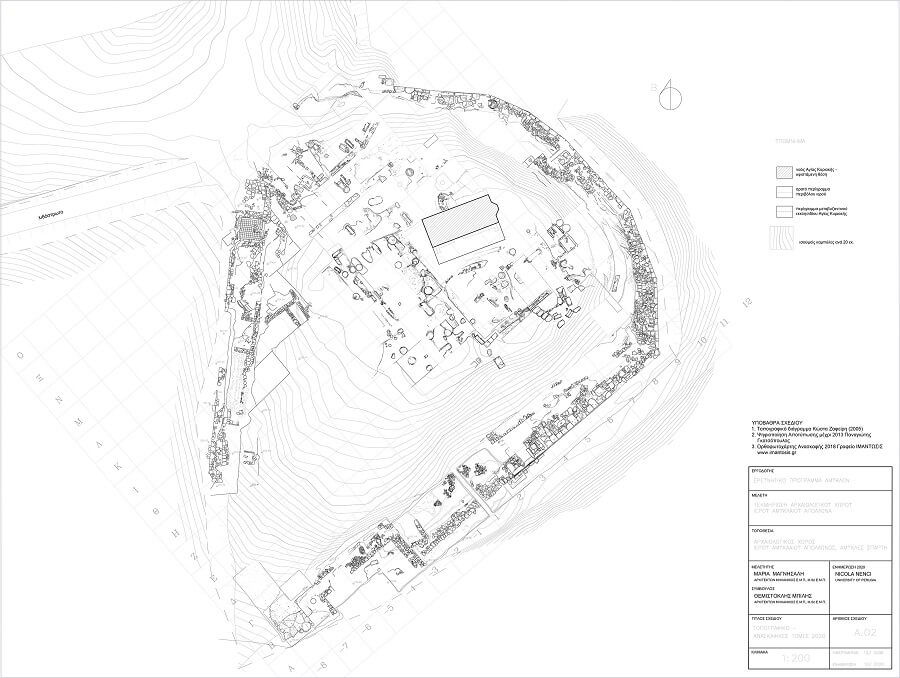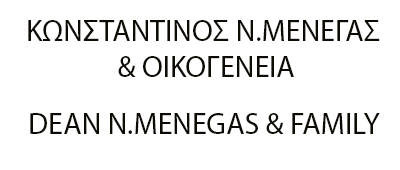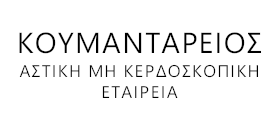Excavation Reports
2020 Report
07-12-2020 13:14The aim of the excavation work, during the 2020 season of the project, was to investigate the hypothesis of a second access to the sanctuary on the eastern slope of the hill of Agia Kyriaki, at the corner of the monumental Archaic precinct wall. This area was partially excavated in the past by E. Buschor [E. Buschor, AM 52 (1927), 30-31, fig. 15, 16], without, however, any evidence regarding its interpretation. Parallel to this, excavation was conducted on the west side of the hill, in particular on the long-narrow construction uncovered in the southern half of the Archaic precinct during the works of the 2016 and 2017 seasons. The purpose of this intervention was to remove a dense layer of tiles, which were initially considered to originate from the roof of the above-mentioned structure.
In particular, over the entire excavated area on the southern slope of the hill, the yellowish porous bedrock (kimilia) was revealed, which is inclined following the fall of the slope from north to south. The stratigraphy was disturbed and consisted of messed soil containing findings of various periods, from Prehistoric to Byzantine times. On the surface of the porous bedrock, piles of large and medium-sized roughly worked stones were found, as well as a part of the foundation of a Byzantine wall, which is also mentioned in E. Buschor's publication [E. Buschor, AM 52 (1927), 30-31, fig. 15, 16]. The structure, measuring 1,33 x 1,80 m., consists of small and medium-sized rubble stones with fragments of tiles and a tenuous lime plaster as mortar. Unfortunately, there is no evidence to support an interpretation of the structure and its integration to the wider architectural context. On the northwestern side of the area, a narrow and thin sector of pebble surface was uncovered on the natural bedrock, similar to the one which had been revealed further west, during previous research work in the wider region.
From the removal of the disturbed layer, with a thickness of about 0,50 m, and in an area without any architectural or monumental context, a significant amount of pottery was collected - ca. 9500 sherds of various periods, most of which are dated to the Geometric times. To the earliest phases belong fragments of handmade vessels of the Early Helladic period with fish-bone engraved decoration, as well as parts of Mycenaean figurines of the Psi type and animal figurines of the same period. The Geometric pottery sherds are decorated with the typical of the period motifs, such as concentric circles, wavy lines, rectangles filled with cross-hatching, etc., while sherds of the Late Geometric period are decorated with human or animal figure scenes. Among the finds are also intact and fragmentary aryballoi of the Archaic period, plenty of them miniatures, a characteristic spout of a Corinthian alabastron baring traces of engraved animal figure scene, parts of stamped or inscribed terracotta tiles and fragments of bronze objects (sheets, jewelry, lead wreaths, etc.).
Based on the excavation results, the initial hypothesis according to which a stepped entrance for the ascent to the sanctuary existed on the southern slope of the hill, can no longer be supported, as it is not archaeologically documented. It is however certain that the area is defined to the south by a precinct, which functioned also as a retaining wall during the Late Geometric and Early Archaic periods. In the 6th century B.C., the cult activity of the sanctuary was transferred outside the Geometric precinct, as it is indicated by the large number of miniature vessels and other votive objects found along the south face of the wall during the last year's excavation.
In the process of removal of the dense layer with the roof tiles on the western slope of the hill, within the space originally interpreted as a rectangular storage building to the south of the Roman constructions and alongside the precinct of the west side of the sanctuary, it was found out that the tile fragments were arranged in two consecutive rows, shaping a quite thick layer of ca. 0,60 m. high. The upper and denser row consists of larger size and higher quality tiles, compared to the roughly made tiles of the second thinner row. Under this and over the whole extent of the structure, a layer of medium-sized rough stones, which was created in order to restrain the weight of the above layers with the tiles, was uncovered. The removal of the stones revealed, within the natural bedrock, a long-narrow ditch measuring 0,64 m. width and 7,70 m. length, which runs the entire structure from north to south. Some 3000 fragments of roof tiles, mostly curved covers and pans of the Laconian type, as well as a few flat pans, were collected. It is worth noting that both the roof tiles and the pottery sherds are dated between the 6th and 9th centuries A.D. Most of the finds are tiles decorated with impressed "fingerprints" and parts of storage vessels, mainly pointed amphorae, which bare engraved ribbed decoration. Finally, several animal bones, a quantity of yellowish and white coloured plaster, iron nails, and parts of marble architectural pieces were also collected.
According to the new information, this area, measuring 2,50 x 11 m., must have been a place, where a large quantity of roof tiles was discarded and it was formed in two phases during the Early Byzantine period, between the 6th and the 9th centuries A.D., when the hill had become a Christian site of worship.
The total amount of the roof tiles was assembled on the side and immediately west of the construction, in an area with the similar shape to it, and the tiles were placed at spots which correspond to their original location, before being moved away.











